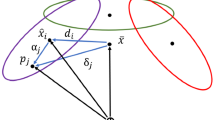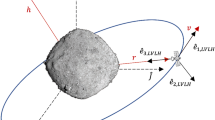Abstract
In the theory of classical mechanics, the two-body central forcing problem is formulated as a system of the coupled nonlinear second-order deterministic differential equations. The uncertainty introduced by the small, unmodeled stochastic acceleration is not assumed in the particle dynamics. The small, unmodeled stochastic acceleration produces an additional random force on a particle. Estimation algorithms for a two-body dynamics, without introducing the stochastic perturbation, may cause inaccurate estimation of a particle trajectory. Specifically, this paper examines the effect of the stochastic acceleration on the motion of the orbiting particle, and subsequently, the stochastic estimation algorithm is developed by deriving the evolutions of conditional means and conditional variances for estimating the states of the particle-earth system. The theory of the nonlinear filter of this paper is developed using the Kolmogorov forward equation “between the observations" and a functional difference equation for the conditional probability density “at the observation." The effectiveness of the nonlinear filter is examined on the basis of its ability to preserve perturbation effect felt by the orbiting particle and the signal-to-noise ratio. The Kolmogorov forward equation, however, is not appropriate for the numerical simulations, since it is the equation for the evolution of “the conditional probability density." Instead of the Kolmogorov equation, one derives the evolutions for the moments of the state vector, which in our case consists of positions and velocities of the orbiting body. Even these equations are not appropriate for the numerical implementations, since they are not closed in the sense that computing the evolution of a given moment involves the knowledge of higher order moments. Hence, we consider the approximations to these moment evolution equations. This paper makes a connection between classical mechanics, statistical mechanics and the theory of the nonlinear stochastic filtering. The results of this paper will be of use to astrophysicists, engineers and applied mathematicians, who are interested in applications of the nonlinear filtering theory to the problems of celestial and satellite mechanics. Simulation results are introduced to demonstrate the usefulness of an analytic theory developed, in this paper.
Similar content being viewed by others
References
Bate, R.R., Mueller, D.D., White, J.E.: Fundamental of Astrodynamics. Dover, New York (1971)
Bierbaum, M.M., Joseph, R.I., Fry, R.L., Nelson, J.B: A Fokker–Planck model for a two-body problem. In: AIP Conference Proceeding, no. 617, pp. 340–371 (2002)
Challam, S., Bar-Shalom, Y.: Non-linear filtering using Fokker-Planck-Kolmogorov equation probability density evolution. IEEE Trans. Aerosp. Electron. Syst. 36(1), 309–314 (2000)
Chang, R.L.: Pre-computed-gain non-linear filters for non-linear systems with state-dependent noise. J. Dyn. Syst. Meas. Control 112, 270–275 (1990)
Daum, F.E.: Exact finite-dimensional non-linear filters. IEEE Trans. Autom. Control 31(7), 765–766 (1986)
Goldstein, H., Poole, C., Safko, J: Classical Mechanics,3rd edn. Pearson Education, Singapore (2002)
Ito, K: Gaussian filter for non-linear filtering problems. In: Proceedings of the IEEE Conference on Decision and Control, Sydney, Australia, vol. 2, pp. 1218–1223 (2000)
Jazwinski, A.H.: Filtering for non-linear dynamical systems. IEEE Trans. Autom. Control 11, 612–622 (1966)
Jazwinski, A.H.: Stochastic Processes and Filtering Theory. Academic, New York (1970)
Kessler, S.A., Cicci, D.A.: Filtering methods for the orbit determination of a tethered satellite. J. Astronaut. Sci. 48(3), 263–278 (1997)
Kushner, H.J.: On the differential equations satisfied by conditional probability densities of Markov processes, with applications. J. SIAM Control 2, 106–119 (1964)
Kushner, H.J.: Approximations to optimal non-linear filters. IEEE Trans. Autom. Control 12(5), 546–556 (1967)
Maura, J.M.F.: A relation between discrete and continuous optimal non-linear filters. In: IEEE International Symposium on Information Theory, St. Jovite, Que., Canada, Sept. 26–30 (1983)
Mehra, R.K.: A comparison of several non-linear filters for re-entry vehicle tracking. IEEE Trans. Autom. Control 16, 307–319 (1971)
O'odonnell, B.: Non-linear filtering of stochastic dynamical systems. Ph.D. Thesis, Iowa State University, Ames, Iowa (1994)
Park, B.T.: Stochastic acceleration in electron-dominated solar flares. Ph. D. Dissertation, Department of Physics, Stanford University, Stanford, CA (1996)
Pugachev, V.S., Sinitsyn, I.N.: Stochastic Differential Systems (analysis and filtering). Wiley, New York (1977)
Sage, A.P., Melsa, M.L.: Estimation Theory with Applications to Communications and Control. Mc-Graw Hill, New York (1971)
Scheeres, D.J., Han, D., Hou, Y.: Influence of unstable manifolds on orbit uncertainty. J. Guid. Control Dyn. 24(3), 573–585 (2001)
Shaikin, M.E.: Optimal estimation equations for state vector of a stochastic bilinear system: its bilinear approximations. Avtomatika i Telemekhanika 65, 1946–1960 (2004)
Sharma, S.N., Parthasarathy, H., Gupta, J.R.P.: Third-order approximate Kushner filter for a non-linear dynamical system. Int. J. Control 79(9), 1096–1106 (2006)
Shirish, D.C., Lo, J.H.: Optimum filters for bilinear systems with nilpotent Lie algebras. IEEE Trans. Aerosp. Electron. Syst. 36, 948–953 (1979)
Synder, D.L.: The state variable approach to continuous estimations. Ph. D. Thesis, M.I.T., Cambridge, MA (1966)
Vergez, P., Sauter, L., Dalke, S.: An improved Kalman filter for satellite orbit predictions. J. Astronaut. Sci. 52(3), 1–22 (2004)
Author information
Authors and Affiliations
Corresponding author
Rights and permissions
About this article
Cite this article
Sharma, S.N., Parthasarathy, H. A two-body continuous-discrete filter. Nonlinear Dyn 51, 155–170 (2008). https://doi.org/10.1007/s11071-007-9199-0
Received:
Accepted:
Published:
Issue Date:
DOI: https://doi.org/10.1007/s11071-007-9199-0




